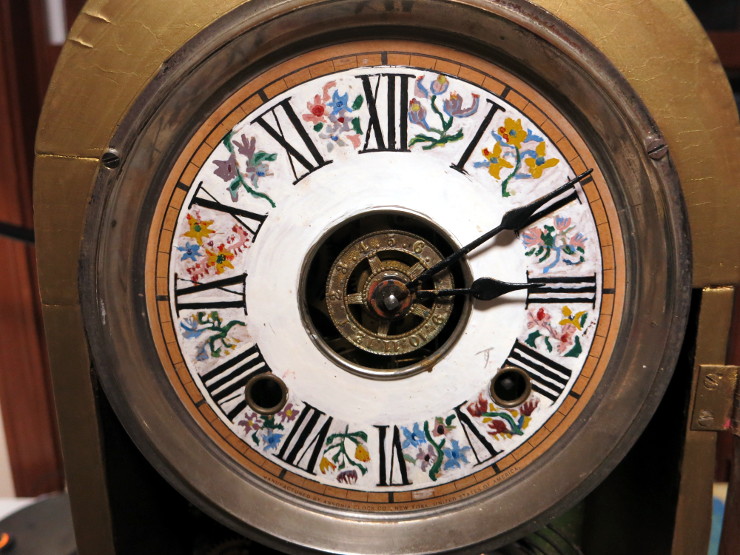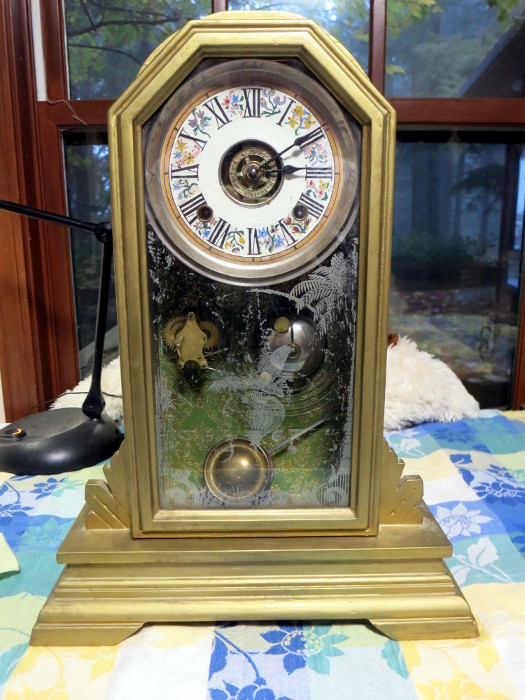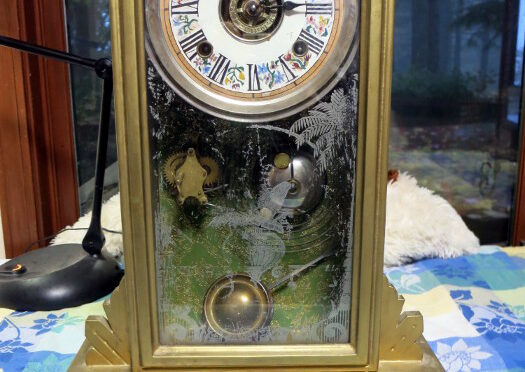Since I was making good progress on my first clock, I decided to haunt the antique malls looking for a second one to repair. I wasn’t really planning to buy a clock until I’d finished the first, but I found the perfect second clock to work on.
I found it in an antique mall in Hillsboro (Oregon). It’s a mantel clock – a Kitchen Clock – similar to my family Seth Thomas clock that is my eventual target for repair (once I know what I’m doing). It also fit the bill of a) not working well, and b) not worth a lot.
The seller was asking $45 for it because it’s an antique Ansonia clock in reasonable working order. I offered $20 and bought it for $25 because the case and pendulum have been heavily altered over the century of the clock’s life.
…not to diminish craft or Crafting. Crafts are artistic expression. It’s just that in this case, I’d like to see more of the original clock that’s hiding under all this paint and alteration.
The first thing I noticed was that the case had been painted… multiple times. The whole thing had been painted gold, and the base showed traces of white underneath the gold. I knew I was going to have to remove all that paint to get to the original wood underneath.
I later learned from Wes at The Clockmaker’s Gallery in Eugene, Oregon that people often paint kitchen clocks that have broken gingerbreading (see below), because any new wood they add wouldn’t match the type and grain of the old.

The inside back had been papered with Christmas wrap.

You can also see in the above picture that the wire running from the alarm to the movement is missing, and the pendulum bob has ugly blobs of solder on the top. I later found this bob is likely not original – the original bob was likely a lovely silver-colored one, with concentric rings and an ornate floral top. At any rate, I knew I’d need to remove that paper.
The face had been painted in a floral motif. Unfortunately, it’s almost impossible to remove such paint without ruining the underlying paper face. Fortunately, I kind of like how some past owner painted this face.

I also noticed the gingerbreading – the elaborately cut wooden plate – from the top of the clock was missing. It seems to have been cut off at some point, possibly in the 1920s or ’30s, when clean, geometric lines had come into fashion and the ornate Victorian styles were out. It also seems part of the gingerbreading may have broken off – I may never know. At any rate, the top arch of the clock is all that remains of the lovely original woodworking. I’ll probably scrollsaw a replacement.
Compare the clock as I found it…

…to a nearly original condition one that appeared in a discussion on an NAWCC message board.

Identifying the clock
Identifying and dating a clock can be tricky, but in this case, there are several strong hints.
First, the movement and face of the clock are labeled “Ansonia Clock Co.”


Second, what looks like the original paper label remains, in poor condition, on the back of the clock. A little work in a photo editor brought out the model name.
![Enhanced photo of the label reads “DERBY” , “Eight [day] Strike”, “Ansonia Clock Company”](https://bluepapertech.com/wp-content/uploads/2023/04/20181031_163702BEnhancedwiki.jpg)
So I’m confident that what I have is an Ansonia “Derby” model, 8-day, striking clock with alarm. One helpful poster to that thread above showed that the Ansonia Derby was first manufactured in 1894. So this clock is no older than 1894. I don’t know when Ansonia discontinued this model, but Ansonia went out of business about 1929.
In my next post about this clock, I remove the damaged remnant of the original gingerbread, in preparation for attaching new gingerbread.

